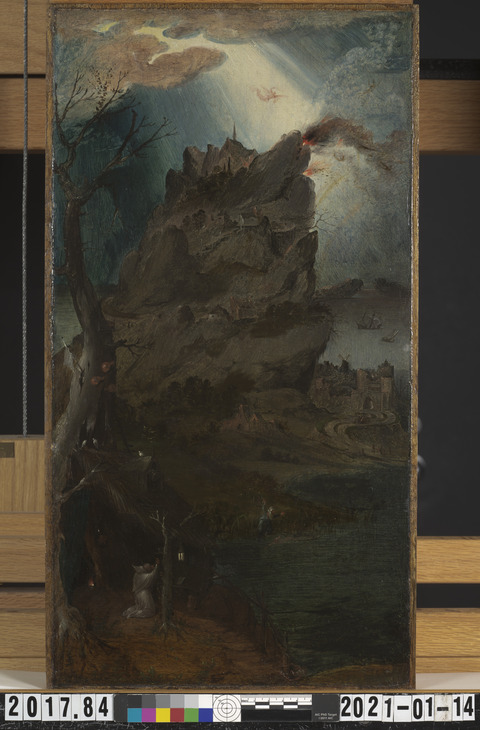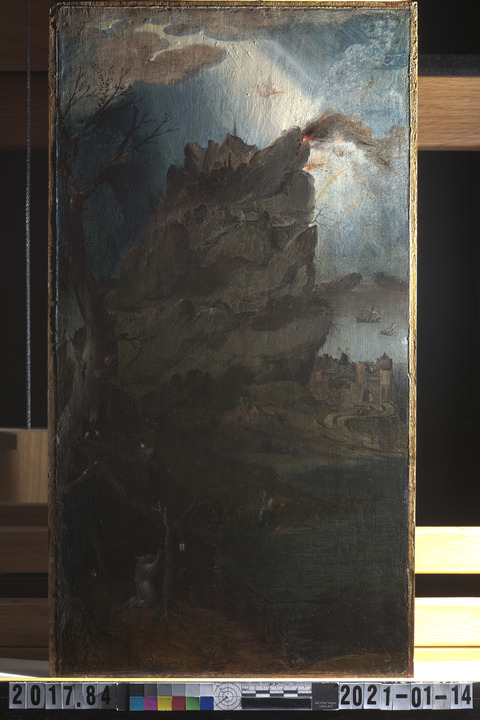Overview
Identification number: 2017.84
Artist: Circle of Jan Wellens de Cock
Title: Landscape with Hermit
Materials: Oil (untested) on Baltic oak panel
Date of creation: Early 1500s
Previous number/accession number: C10013
Dimensions: 49 ×26.6 cm
Conservator/examiner: Roxane Sperber
Examination completed: 2021
Distinguishing Marks
Front:
None
Back:
None
Summary of Treatment History
Physical evidence suggests the painting has been significantly altered from its original construction. An engaged frame was removed, and the original support has been thinned and marouflaged to a secondary panel support. Additionally, a cradle was applied to the back. The painted area does not appear to have been trimmed, although the original panel may have been larger. The painting has significant passages of old retouching and has certainly undergone aesthetic interventions, such as varnish removal, likely numerous times. No documentation of such interventions has been retained.
Records from the Clowes Registration Archive record a minor conservation treatment to lay down blisters done in June of 1966 at the Newhouse Galleries in New York. 1 A technical examination and X-radiograph of the painting were also carried out at the Fogg Museum in September 1966. In that report, the panel was described as having an oak support with a second layer of Masonite and a walnut veneer backing. Losses and repaint were also noted.2
There are no records for conservation treatment of the painting after it entered the IMA on long-term loan in 1971; however, documentation suggests a series of condition assessments and treatments were carried out on the collection around the time the works were moved from the Clowes' residence to the IMA. A condition report by Paul Spheeris in October of that year, likely carried out before the paintings were relocated, described the painting as “O.K.,” and no treatment was recommended.3 A second condition assessment was carried out upon arrival of the paintings at the IMA. This assessment describes the work as in good condition, and no work was deemed necessary.4
In 1974, a condition assessment, treatment, and investigation of the collection was carried out by the Intermuseum Conservation Association at Oberlin College. This document describes the painting in its current construction and noted that it was in stable condition. No treatment or further examination was recommended.5
The condition of the painting was recorded in the Clowes Collection annual survey from 2011 to 2020.
Current Condition Summary
The painting is in generally good condition but would greatly benefit from conservation treatment. The structure of the painting is sound, but the aesthetics are suffering from a severely darkened and desaturated varnish layer that is obscuring the surface detail in the painting. There are significant passages of old retouching visible when viewed under ultraviolet-induced visible fluorescence.
Methods of Examination, Imaging, and Analysis
| Examination/Imaging | Analysis (no sample required) | Analysis (sample required) |
|---|---|---|
Unaided eye | Dendrochronology | Microchemical analysis |
Optical microscopy | Wood identification | Fiber ID |
Incident light | Microchemical analysis | Cross-section sampling |
Raking light | Thread count analysis | Dispersed pigment sample |
Reflected/specular light | X-ray fluorescence spectroscopy (XRF) | Fourier-transform infrared spectroscopy (FTIR) |
Transmitted light | Macro X-ray fluorescence scanning (MA-XRF) | Raman microspectroscopy |
Ultraviolet-induced visible fluorescence (UV) | ||
Infrared reflectography (IRR) | Gas chromatography–mass spectrometry (GC-MS) | |
Infrared transmittography (IRT) | Scanning electron microscope -energy dispersive X-ray spectroscopy (SEM-EDS) | |
Infrared luminescence | Other: | |
X-radiography |
Technical Examination
Description of Support
Analyzed Observed
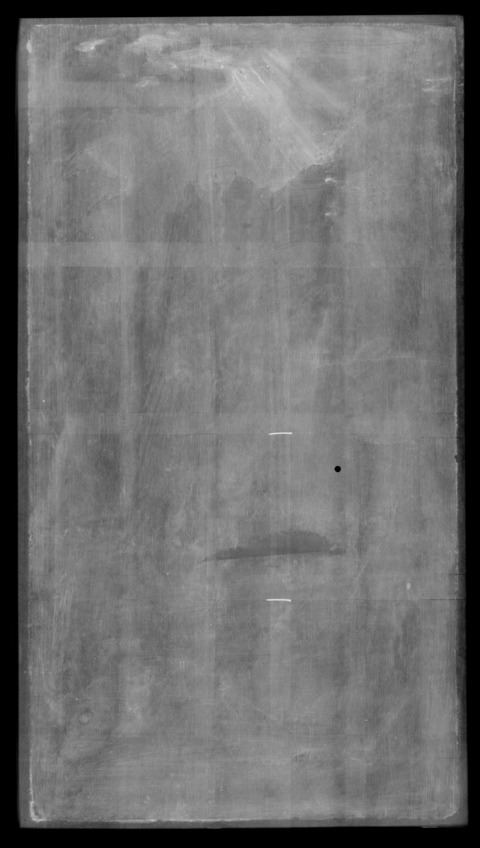
Material Type (fabric, wood, metal, dendrochronology results, fiber ID information, etc.):
The original support is a single oak panel with vertically oriented grain. Dendrochronology of the support by Peter Klein determined the last heartwood ring to date to 1478. Klein suggests the earliest possible date for the painting is 1489, but likely after 1503.6 The question of how long planks were seasoned in the fifteenth and sixteenth centuries is a topic of some debate. Current research into this area may suggest an even earlier terminus post quem of 1484.7
Characteristics of Construction/Fabrication (cusping, beveled edges of panels, seams or joins, battens):
The original oak support was subsequently thinned and marouflaged to another panel (5 mm thick), leaving only 1 mm of the original support. There is a barb present along the edges of the paint layer suggesting the work originally had an engaged frame and may have been part of a larger altarpiece. Wood from the original panel extends beyond the margins of the painted surface on all edges. The distinctive wood grain is visible along these exposed edges.
In the X-radiograph, two horizontally positioned nails are visible toward the center of the panel in the lower half of the composition (tech. fig. 1). Given that the nails appear relatively modern, and the original support is only 1 mm thick, it is quite certain that they do not relate to the original construction of the panel. Close examination suggests these nails are not present in the cradle. It is therefore likely that the nails are present in the 5-mm-thick panel to which the original support was marouflaged.
Thickness (for panels or boards):
The full construction is 29 mm thick. The original panel is 1 mm thick. The panel has been marouflaged to a 6-mm-thick panel and the veneer that supports the cradle is 1 mm thick. The cradle adds an additional 21 mm of thickness.
Production/Dealer’s marks:
None
Auxiliary Support:
Original Not original Not able to discern None
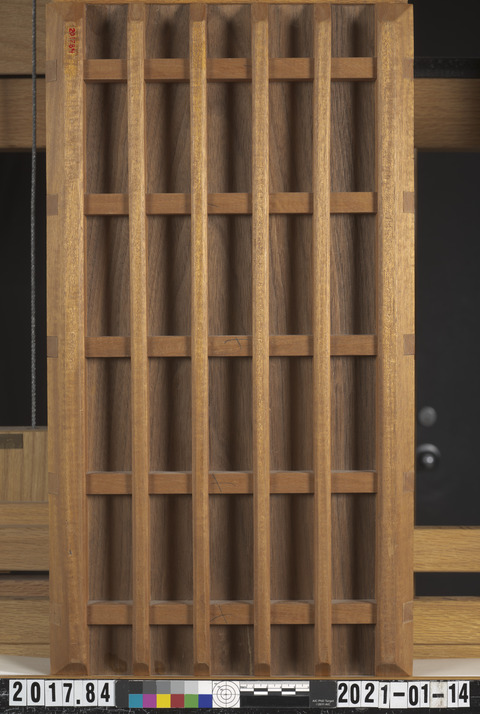
The auxiliary support consists of a secondary panel into which the original panel was marouflaged. This panel has been backed with a wood veneer to which a cradle has been glued.
The cradle is robust and well-constructed (tech. fig. 2). It is composed of six vertical members. The central four members are 1 cm wide and have rounded edges. The two outer members are 3 cm wide with beveled and rounded edges. There are five horizontal members that were designed to be movable but all of which have seized. The horizonal bars have squared corners and are 1.5 cm wide.
Glue residues are present along the bottom edge of the back.
Weave (structure, weight, thread thickness, etc):
N/A
Condition of Support
The painting has been significantly altered from its original construction. The engaged frame was removed, and the original support thinned and marouflaged to a secondary panel support. Additionally, a cradle was applied to the back. The composition does not appear to have been trimmed, although the original panel may have been larger. In its current configuration, the support is stable and in good condition. There are no major losses or cracks.
Description of Ground
Analyzed Observed
Materials/Binding Medium:
XRF analysis detected calcium in the ground layer. FTIR analysis confirmed that the ground was composed of calcium carbonate (chalk). Lead was also detected in the ground using XRF (see table 1, sample 1). It is possible that the calcium ground was covered with a lead-white-containing imprimatura.
Color:
The ground is a buff color.
Application:
A raised barb is present around the edge of the composition indicating that the ground was applied after the panel was fitted to an engaged frame. The ground is generally even and was likely applied with a brush and later sanded smooth.
Thickness:
The ground is thinly applied in a single layer.
Sizing:
Microscopic analysis suggests a sizing layer was applied to the panel before the application of the ground.
Character and Appearance (Does texture of support remain detectable/prominent?):
The thin application of the ground has left the texture of the wood support partially visible when the painting is viewed under raking light.
Condition of Ground
The ground is in generally good condition. The adhesion is strong between the panel and the ground despite previous interventions to the structure of the painting. There is a triangular area in the center of the painting that is less dense in the X-radiograph and may correspond to a loss in the ground and paint layers.
Description of Composition Planning
Methods of Analysis:
Surface observation (unaided or with magnification)
Infrared reflectography (IRR)
X-radiography8
Analysis Parameters:
| X-Ray equipment | GE Inspection Technologies Type: ERESCO 200MFR 3.1, Tube S/N: MIR 201E 58-2812, EN 12543: 1.0mm, Filter: 0.8mm Be + 2mm Al |
|---|---|
| KV: | 26 |
| mA: | 3.0 |
| Exposure time (s) | 90 |
| Distance from x-ray tube: | 36” |
| IRR equipment and wavelength | Opus Instruments Osiris A1 infrared camera with InGaAs array detector operating at a wavelength of 0.9-1.7µm. |
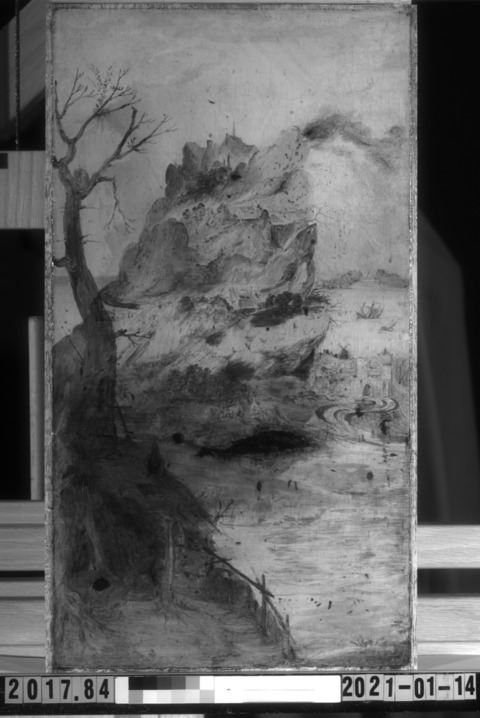
Medium/Technique:
There is no evidence of underdrawing visible in infrared reflectography (tech. fig. 3). The quick, brushy application of a wash layer (see Description of Paint) may suggest that the composition was not carefully planned before the painting stage but rather was blocked out in paint. It is also possible that the composition was outlined using a medium that does not strongly absorb in infrared.
Description of Paint
Analyzed Observed
Application and Technique:
The composition was blocked in first with a dilute, washy application of paint using a wide, coarse brush. This is visible in the rock, sky, and water. The lines created from the coarse brush hairs are visible through the painting, especially in the sky. Technical figure 4 shows the hatched application of the thin, blue paint in the sky.
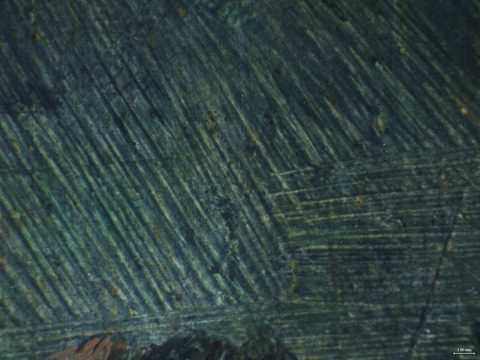
Over the quickly applied blocking-in layer, smaller brushes were used to create minute scenes with a higher level of detail. Technical figure 5 shows the careful depiction of a ship using tiny brushes applied over the thin, brushy application of the water. It is possible that the blocking in of the composition was carried out by one member of the workshop, and the finer details were applied by another hand entirely. The tree in the foreground extends over the mountainous rock suggesting the tree may have been added later by a different member of the workshop, perhaps the person responsible for painting the scene with the hermit.
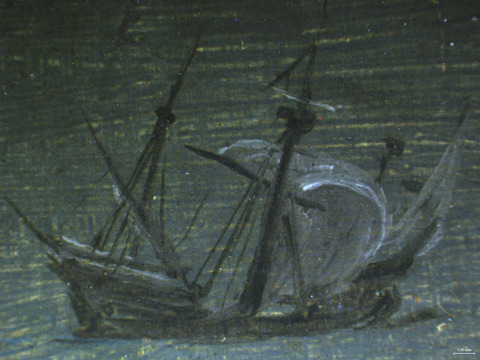
The figures are applied in thick dabs of paint in a loose, expressive style using small brushes (tech. fig. 6).
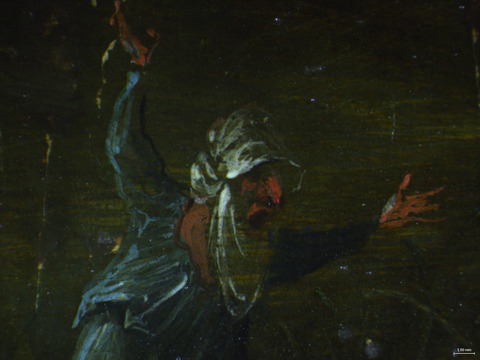
In some areas, such as the clouds and landscape, more texture is added by dragging the paint, possibly with a finger or another blunt instrument (tech. figs. 7, 8).
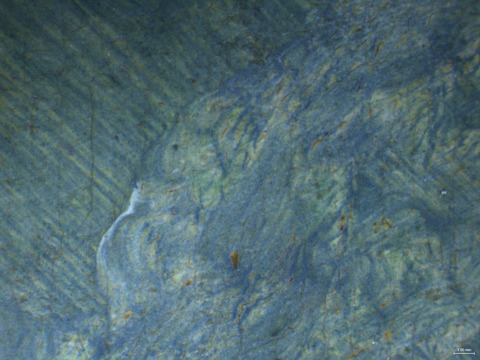
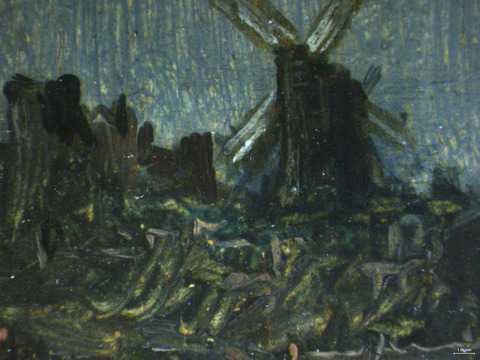
Painting Tools:
Numerous tools were used to create this small painting, including large coarse brushes, small detail brushes, and fingers or another blunt instrument for dabbing and scratching into the paint (tech. figs. 7, 8).
Binding Media:
The binding medium has not been tested, but it is likely drying oil.
Color Palette:
The painting has a generally dark, limited palette composed of browns, grays, and blues punctuated with dabs of red, yellow, and orange. XRF analysis of the paint layer detected elements that were indicative of a palette composed of copper-containing green and blue pigments (likely azurite), iron oxide earth pigments including umber, vermilion, lead white, and lead-tin yellow.
XRF Analysis:
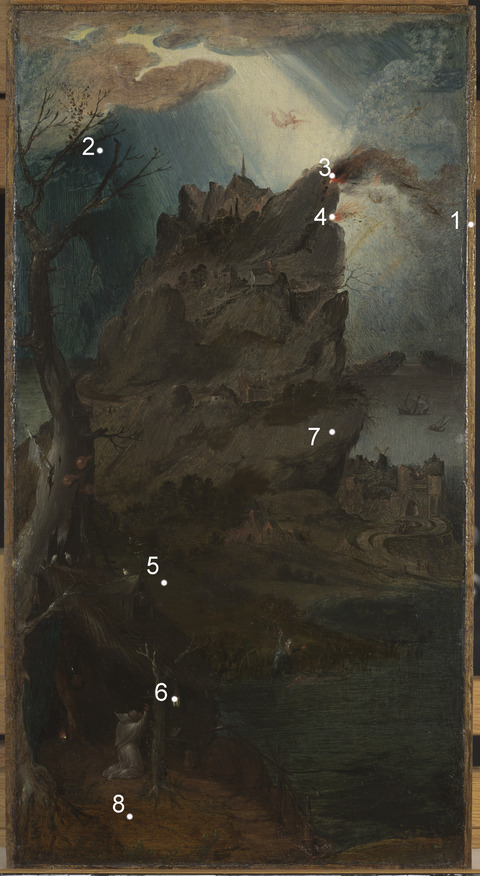
| Sample | Location | Elements | Possible Pigments |
|---|---|---|---|
| 1 | Ground | Major: Ca, Pb Minor: Trace: Fe | Calcium-containing ground, lead white, trace of iron oxide (earth pigments) |
| 2 | Blue sky | Major: Cu Minor: Pb Trace: Ca, Fe | Copper-containing blue pigment (azurite), lead white, trace of calcium-containing ground layer, trace of iron oxide (earth pigments) |
| 3 | Red fire | Major: Hg, Pb Minor: Cu Trace: Ca, Fe | Vermilion, copper-containing blue pigment (azurite), lead white, calcium-containing ground layer, trace of iron oxide (earth pigments including umber) |
| 4 | Yellow fire | Major: Pb, Hg Minor: Sn Trace: Ca, Cu | Lead white, vermilion, lead-tin yellow, trace of copper-containing green and/or blue pigment, trace of calcium from ground layer, |
| 5 | Green grass in the midground | Major: Pb, Cu Minor: Cu Trace: Hg, Fe, Sn | Lead white, copper-containing green and/or blue pigment, calcium from ground layer, trace of iron oxide (earth pigments), trace of vermilion, trace of lead-tin yellow. |
| 6 | Yellow lamp | Major: Pb Minor: Cu, Ca, Sn Trace: Hg, Fe | Lead white, lead-tin yellow, copper-containing green and/or blue pigment, trace of calcium from ground layer, trace of vermilion, trace of iron oxide (earth pigments) |
| 7 | Gray rock | Major: Pb, Ca Minor: Hg, Fe, Cu Trace: | Lead white, carbon black (not confirmed with XRF), calcium from ground layer, copper-containing green and/or blue pigment (likely azurite), iron oxide (earth pigments), vermilion. |
| 8 | Brown foreground | Major: Pb, Ca, Cu Minor: Hg, Fe Trace: Mn, K | Lead white, copper-containing green and/or blue pigment (likely azurite), vermilion, iron oxide (earth pigments including umber), calcium from ground layer. |
Table 1: Results of X-ray fluorescence analysis conducted with a Bruker Artax microfocus XRF with rhodium tube, silicon-drift detector, and polycapillary focusing lens (~100μm spot).
*Major, minor, trace quantities are based on XRF signal strength not quantitative analysis
Surface Appearance:
Although the ground is smooth, brushwork and impasto are visible on the surface of the painting giving it a dynamic appearance.
Condition of Paint
The paint layer is in generally good condition. There is a large loss at the center of the image and localized losses across the surface. There is minimal abrasion to the paint layer in some localized areas.
Description of Varnish/Surface Coating
Analyzed Observed Documented
| Type of Varnish | Application |
|---|---|
Natural resin | Spray applied |
Synthetic resin/other | Brush applied |
Multiple Layers observed | Undetermined |
No coating detected |
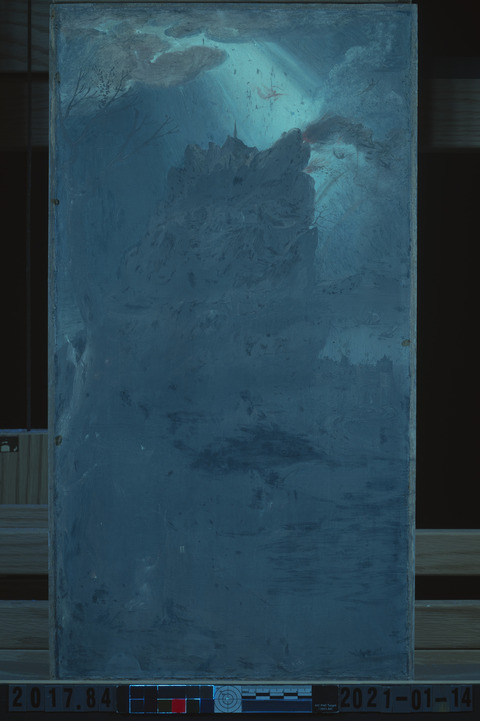
There is a thick, evenly applied layer of varnish that luminesces in ultraviolet-induced visible fluorescence (tech. fig. 10). The fluorescence is greenish-blue, suggesting it may be a natural resin varnish.
Condition of Varnish/Surface Coating
The varnish coating has darkened, obscuring the surface detail in the painting. Further, the coating has become desaturated making it difficult to appreciate details in the dark areas. Areas of retouching are visible in the ultraviolet-induced visible fluorescence image. Because the painting is very dark, it is, in some cases, difficult to spot these areas on the painting even when using microscopy.
Description of Frame
Original/first frame
Period frame
Authenticity cannot be determined at this time/ further art historical research necessary
Reproduction frame (fabricated in the style of)
Replica frame (copy of an existing period frame)
Modern frame
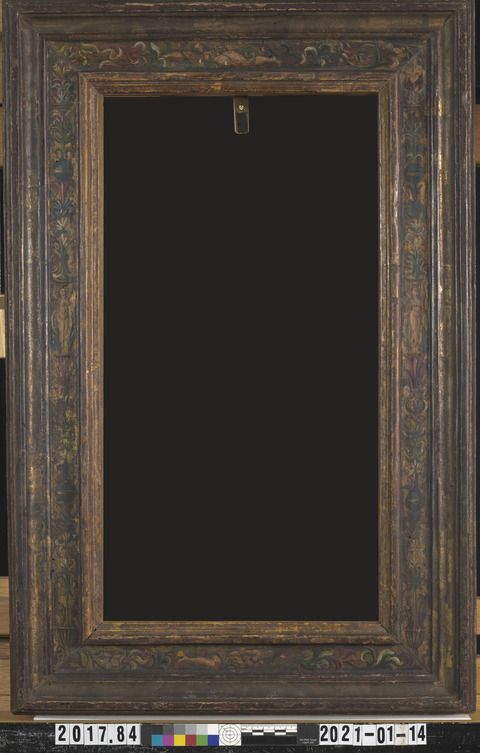
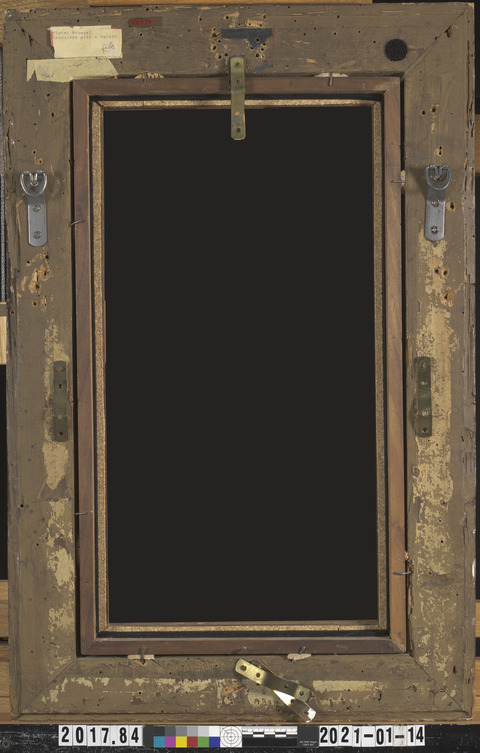
Frame Dimensions:
Outside frame dimensions: 65.6 × 43 × 5 cm
Sight size: 47.9 × 24.9 cm
Distinguishing Marks:
Item 1. Paper label, upper-left corner of frame, typed “Pieter Bruegel/ Landscape with aHermit,” handwritten “R4” (tech. fig. 13).
Item 2. Painted inscription, upper-left corner of frame, red paint “2017.84” (tech. fig. 13).
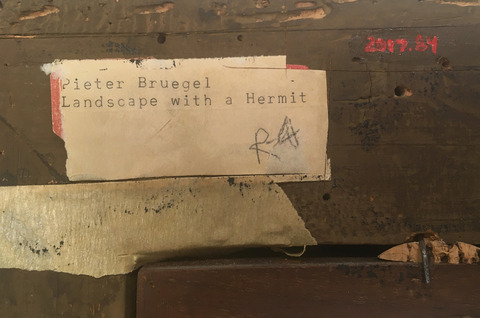
Description of Molding/Profile:
The frame is a cassetta-style frame (tech. fig. 11) that is constructed from wood with mitered corner joins (tech. fig. 12). The molding profile is carved from wood and covered with a dark red bole and a water-gilt surface. Over the gilding, a floral motif is painted on the flat central frieze. Nude figures holding up vases are present in the center of the right and left sides.
Condition of Frame
The frame is in acceptable condition. The structure is sound, but there are some losses to the gilding and abrasion to the painted surface.
Notes
-
See File C10013 (2017.84), Clowes Registration Archive, Indianapolis Museum of Art at Newfields. The “deterioration of the Brueghel ‘Landscape with Hermit’” was also noted in a letter from Allen Clowes to Bertram Newhouse dated 15 June 1966, File C10013 (2017.84), Clowes Registration Archive, Indianapolis Museum of Art at Newfields. ↩︎
-
“Pieter Bruegel the Elder, attrib. to/Landscape with a Hermit,” File C10013 (2017.84), Clowes Registration Archive, Indianapolis Museum of Art at Newfields. ↩︎
-
Paul A.J. Spheeris, “Conservation Report on the Condition of the Clowes Collection,” 25 October 1971, Conservation Department Files, Indianapolis Museum of Art at Newfields. ↩︎
-
Martin Radecki, Clowes Collection condition assessment, undated (after October 1971), Conservation Department Files, Indianapolis Museum of Art at Newfields. ↩︎
-
Intermuseum Conservation Association, “Clowes Collection Conservation Report,” C10013 (2017.84), 8–10 April 1974, Conservation Department Files, Indianapolis Museum of Art at Newfields. ↩︎
-
Peter Klein, dendrochronological analysis report, C10013 (2017.84), 25 June 1999, Conservation Department Files, Indianapolis Museum of Art at Newfields. It should also be noted that the very thin remaining panel (1 mm) can make error more likely in this form of analysis. ↩︎
-
Personal communication with Ian Tyers, 5 February 2021. ↩︎
-
Elvacite 2040 (synthetic resin) was used to fill the cradle so that its appearance would be minimized in the X-radiograph, allowing the composition to be better interpreted. ↩︎
Additional Images
